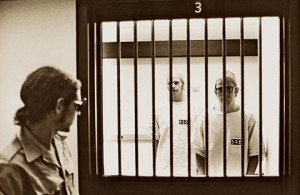by Tinako
[The opinions expressed in these essays do not necessarily reflect the position of ARAUNY.]
I’m taking a Wesleyan University Social Psychology MOOC via Coursera.com. As with everything I read, hear, or watch, I can’t help but also consider the material in terms of animal rights.
This week we’re learning about situations which often cause normal people to behave pathologically, that is, badly. Sometimes very badly. The examples are infamous: Milgram’s shock experiments, Asch’s conformity research, and Zimbardo’s Stanford Prison Experiment. Oh, and we discussed lynchings, Abu Ghraib, abusive military training, and the Holocaust, too. It has been a depressing week.
Did you know that Stanley Milgram’s experiment was a response to the common belief that the Holocaust was a uniquely German phenomenon, a national flaw, and he expected the Americans he tested to behave better? He was wrong. He was the earliest of the experimenters to discover that situation is extremely powerful and can hijack our normal responses. Many other experiments have borne this out: across time, across place, across culture, sex, age, class, and race, certain situations predictably have the potential to override our common sense and decency.
Ordinary people, simply doing their jobs, and without any particular hostility on their part, can become agents in a terrible destructive process. Moreover, even when the destructive effects of their work become patently clear, and they are asked to carry out actions incompatible with fundamental standards of morality, relatively few people have the resources needed to resist authority. – Stanley Milgram
It’s an important point that in the shock experiments people would disobey, by objecting, but their disobedience was ineffective, and the majority ultimately continued to the end.
The Stanford Prison Experiment, exploring what happens to normal people arbitrarily placed in differing power roles, has particularly made me think of the people caught in our animal farming system. We read about or see them on video beating animals, gleefully stomping on them, or carelessly feeding them alive into an auger, and we say, “Not Me!”
The SPE and these other experiments say “Yes, maybe You.”

Asch Conformity Experiment: What would you do if everyone else in the room confidently said line 1 was the same length as the “Standard Line”?
The lesson from experiment after experiment is that you really have no idea how you would behave if you were in their shoes. The professor, Scott Plous, says,
The main point of Milgram’s research wasn’t that 65% of people in the baseline condition deliver the highest electric shock [450v], it is that under certain circumstances, people will obey a stranger’s command to hurt another person. The main point of Asch’s [conformity] research wasn’t that people will conform on 32% of all critical trials, it’s that under certain circumstances, people will go along with the group, even if it means contradicting the evidence of their own senses. And in the SPE, the main point wasn’t that guards will become abusive [some] percent of the time, it’s that we need to guard ourselves against situational factors that can lead us to behave destructively.
Perhaps putting ourselves in control of other species for the purpose of using them is one of those situations that will often lead us to behave contrary to our values.
The “prison guards” in the SPE were victims of an unethical experiment. And animal abusers in the livestock industry may be the other victims of an unethical industry.
Phillip Zimbardo has dedicated his life to trying to make his experiment useful, to counteract the real harm it did to the participants. You can visit his Stanford Prison website and watch his 50-minute film “Silent Rage” on Youtube. Or check out week 3 of Coursera’s course, which includes many copyrighted works available free until June 2015.



